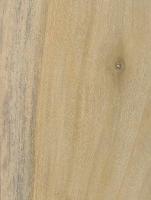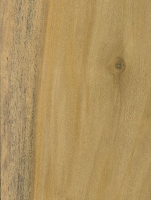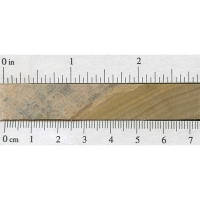 |
Common Name(s): Cucumbertree, Cucumber Magnolia Scientific Name: Magnolia acuminata Distribution: Eastern United States Tree Size: 50-80 ft (15-24 m) tall, 2-3 ft (.6-1 m) trunk diameter Average Dried Weight: 33 lbs/ft3 (530 kg/m3) Specific Gravity (Basic, 12% MC): .44, .53 Janka Hardness: 700 lbf (3,110 N) Modulus of Rupture: 12,300 lbf/in2 (84.8 MPa) Elastic Modulus: 1,820,000 lbf/in2 (12.55 GPa) Crushing Strength: 6,310 lbf/in2 (43.5 MPa) Shrinkage: Radial: 5.2%, Tangential: 8.8%, Volumetric: 13.6%, T/R Ratio: 1.7 |
Color/Appearance: Very wide sapwood is a creamy white to grayish color. Comparatively narrow heartwood color ranges from a medium to dark brown, sometimes with green, purple or black streaks.
Grain/Texture: Grain is straight, with a fine, uniform texture. Moderate natural luster.
Endgrain: Diffuse-porous; small pores in no specific arrangement; solitary and radial multiples of 2-3; growth rings distinct; rays faintly visible without lens; parenchyma banded (marginal).
Rot Resistance: Rated as non-durable to perishable regarding decay resistance, and also susceptible to insect attack.
Workability: Generally easy to work with both hand and machine tools. Turns, glues, stains, and finishes well.
Odor: No characteristic odor.
Allergies/Toxicity: Although severe reactions are quite uncommon, species in the Magnolia genus have been reported to cause asthma-like symptoms and runny nose. See the articles Wood Allergies and Toxicity and Wood Dust Safety for more information.
Pricing/Availability: Cucumbertree is frequently mixed with Yellow Poplar (also in the Magnoliaceae family) and sold interchangeably as Yellow Poplar. Prices should be low for a domestic hardwood.
Sustainability: This wood species is not listed in the CITES Appendices or on the IUCN Red List of Threatened Species.
Common Uses: Veneer, plywood, interior trim, upholstered furniture frames, and general utility wood.
Comments: So named because the tree’s unripe fruit is green and resembles small cucumbers. Cucumbertree is actually related to other species of Magnolia, and the woods within the genus can’t be reliably separated visually. Additionally, Magnolia species are very difficult to tell apart from Yellow Poplar (Liriodendron tulipifera), and typically microscopic examination is necessary to distinguish the two genera.
None available.
 |
 |
 |
 |





Anyone ever see cucumber tree wood like this?
I’ve seen pieces of related magnolia with very dark heartwood like that. Here’s a picture of southern magnolia with very dark heartwood.
This is in western Ny
The tree experienced severe fire or other damage during its life time. Trees below surface mines that pushed spoil over the hillside will also show evidence of stress. This effect is called mineral stain.
Just finished a table from a slab of cucumber. It was a lot of work to get it flat and true but worth the effort. Don’t over look this wood.
The finished top.
Awesome! Wish Inhad some of this beautiful wood to turn
Largest Cucumber Magnolia I’ve ever seen and I can’t find anything this large on record. This tree was 62″ DBH and I will make some beautiful slabs. .